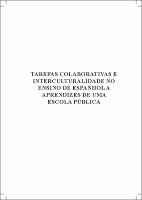| Compartilhamento |


|
Use este identificador para citar ou linkar para este item:
https://deposita.ibict.br/handle/deposita/88Registro completo de metadados
| Campo DC | Valor | Idioma |
|---|---|---|
| dc.contributor.author | Trindade Natel, Tania Beatriz | - |
| dc.date.accessioned | 2019-10-22T14:49:51Z | - |
| dc.date.issued | 2019 | por |
| dc.identifier.isbn | 978-85-68419-81-6 | por |
| dc.identifier.uri | https://deposita.ibict.br/handle/deposita/88 | - |
| dc.description.resumo | Ensinar uma língua estrangeira em escolas públicas brasileiras é um desafio. Requer profundos conhecimentos linguísticos, pedagógicos e didáticos. Mas acima de tudo, requer práticas colaborativas realizadas por meio de tarefas colaborativas com assuntos retirados da realidade onde os alunos estão inseridos. Para, em seguida, ir além, ensinar língua e cultura para além da visão local, ensinar para que os alunos se tornem cidadãos interculturais. Tarefas colaborativas e interculturalidade no ensino de espanhol a aprendizes de uma escola pública atribui valor à língua espanhola e às interações que surgem no ensino-aprendizado desse idioma na escola pública. Além disso, proporciona aos professores de línguas estrangeiras, mas principalmente aos de espanhol, formados e em formação, o acesso a questões teóricas e práticas relacionadas ao ensino da língua espanhola. | por |
| dc.description.abstract | This study presents the result a project for ninth grade elementary school students using collaborative tasks in order to promote the teaching-learning of the Spanish language and observe whether those tasks promote collaboration, scaffolding and linguistic and intercultural learning. The students’ perceptions about the classroom tasks and whether they believe these promote learning, enable participation, scaffolding and collaboration to learn the target language were examined. Moreover, the faculty was given the opportunity to learn a set of collaborative tasks. The data was generated at a municipal school in Porto Alegre with a ninth-grade group of students. The project “The local experiences in the learning of the Spanish language as knowledge of language and culture” had a variety of collaborative tasks and the study topics were based on the learners’ reality. This pedagogical proposal was developed in two trimesters and it integrated the planning of the regular teacher of the class and it was part of the discipline assessment as well as the students’ self-assessment. For the theoretical framework, support was sought on the Vygotskian sociocultural theory (1978, 1987,1988, 2000), Lantolf (2000, 2006, 2008, 2014), Mitchell, Myles and Marsden (2013), among others; on the culture and interculturality studies of Fannes and Hapgood (1997), Abadía (2000) and Kramsch (1993,1998, 2000, 2009, 2010, 2013); on teaching through projects proposed by Hernández and Ventura (1998), Hernández (2004), Stoller (1997, 2002, 2006) and Sheppard and Stoller (1995) and on collaborative tasks Wesche and Skehan (2002), Swain (1995, 1999, 2000, 2001, 2006), Swain and Lapkin (2001), Lima and Pinho (2007). From the methodological standpoint, this is a qualitative, interpretivist and interventionist research, considering it is a collaborative action-research according to Brandão (1981), Moita Lopes (1996), Telles (2002) and Richard (2003). In order to generate the data, it was used audio and video recording, the written texts produced by the students and a record, in the form of a diary, which has their perceptions about the learning of the Spanish language. The results show evidence that the project, which had several collaborative tasks, demonstrated to be a potentiating tool to learn the new language, considering the fact that many students were able to interact among themselves and collaborate with the linguistic learning. Furthermore, the results show indication of scaffolding, since the students helped each other at the execution of collaborative tasks, focusing on the target language meaning as well as form. In addition, based on the students’ perceptions on this study, evidences indicate that the developed collaborative tasks did provide the learning of the Spanish language. | eng |
| dc.description.provenance | Submitted by Brazil Publishing (tonymartins@aeditora.com.br) on 2019-07-03T08:35:02Z No. of bitstreams: 1 Miolo_Tania_Final.pdf: 2973425 bytes, checksum: 8ec177963d6d2a4190a5174664429cea (MD5) | eng |
| dc.description.provenance | Approved for entry into archive by Lucas Paganine (lucaspaganine@ibict.br) on 2019-10-22T14:49:51Z (GMT) No. of bitstreams: 1 Miolo_Tania_Final.pdf: 2973425 bytes, checksum: 8ec177963d6d2a4190a5174664429cea (MD5) | eng |
| dc.description.provenance | Made available in DSpace on 2019-10-22T14:49:51Z (GMT). No. of bitstreams: 1 Miolo_Tania_Final.pdf: 2973425 bytes, checksum: 8ec177963d6d2a4190a5174664429cea (MD5) Previous issue date: 2019 | eng |
| dc.format | application/pdf | * |
| dc.thumbnail.url | http://deposita.ibict.br/retrieve/949/Miolo_Tania_Final.pdf.jpg | * |
| dc.language | por | por |
| dc.publisher | Brazil Publishing | por |
| dc.publisher.country | Brasil | por |
| dc.rights | openAccess | por |
| dc.subject | Ensino-aprendizagem | por |
| dc.subject | Sociocultural theory | eng |
| dc.subject | Ensino de espanhol | por |
| dc.subject | Escola pública | por |
| dc.subject | Interculturalidade | por |
| dc.subject | Culture | eng |
| dc.subject | Interculturality | eng |
| dc.subject | Foreign language learning | eng |
| dc.subject | Teaching through projects | eng |
| dc.subject | Collaborative tasks | eng |
| dc.subject.cnpq | Ciências Humanas | por |
| dc.title | Tarefas Colaborativas e Interculturalidade | por |
| dc.type | Livro | por |
| Aparece nas coleções: | Sul | |
Arquivos associados a este item:
| Arquivo | Descrição | Tamanho | Formato | |
|---|---|---|---|---|
| Miolo_Tania_Final.pdf | 2,9 MB | Adobe PDF |  Baixar/Abrir Pré-Visualizar |
Ferramentas do administrador

